Documents: Go to download!
- Owner's manual - (English)
- Getting to Know Your TV
- Using the Remote
- Using the On-Screen Menu
- Using the USB Media Player
- TROUBLESHOOTING
Table of contents
Owner's Guide Televisions
Getting to Know Your TV
FRONT PANEL
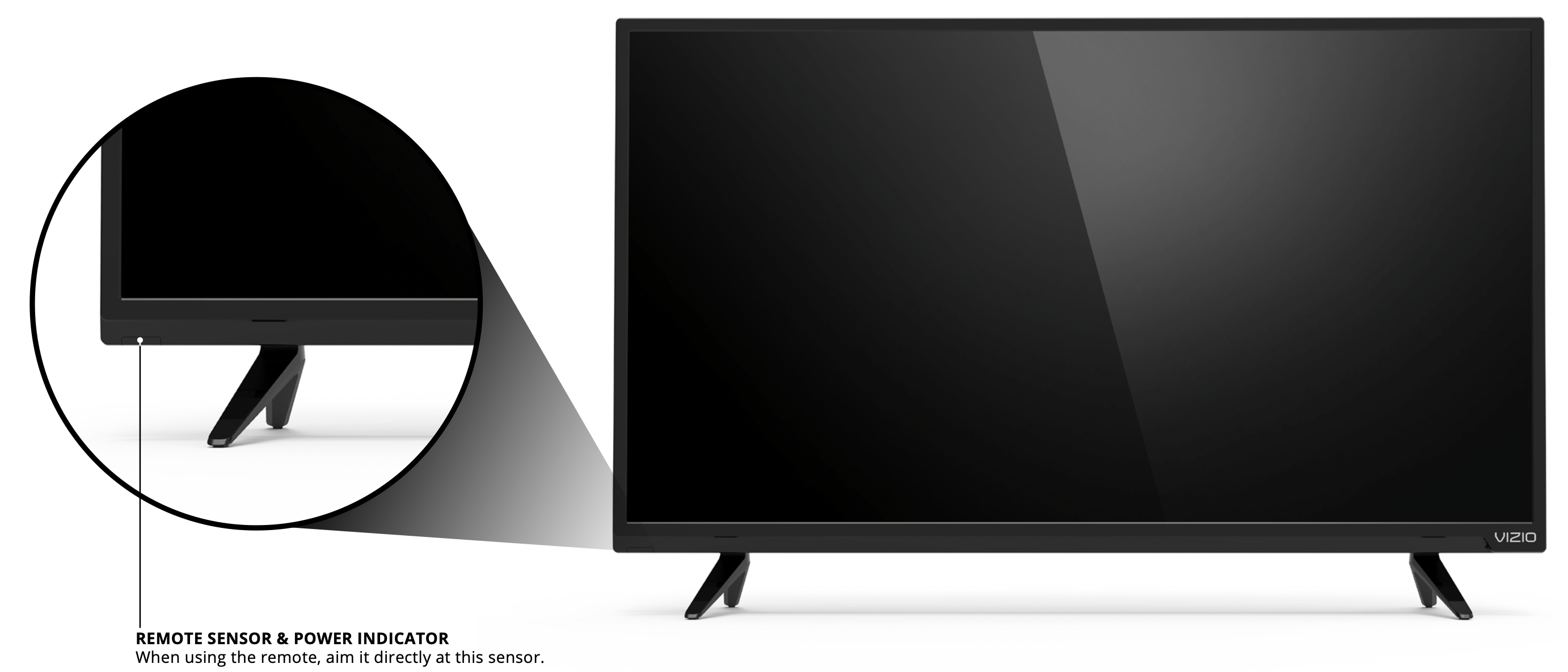
The power indicator flashes on when the TV turns on, then goes out after several seconds.
To keep the power indicator on as long as the TV is on, see Turning the Power Indicator On or Off on page 33.
REAR PANEL
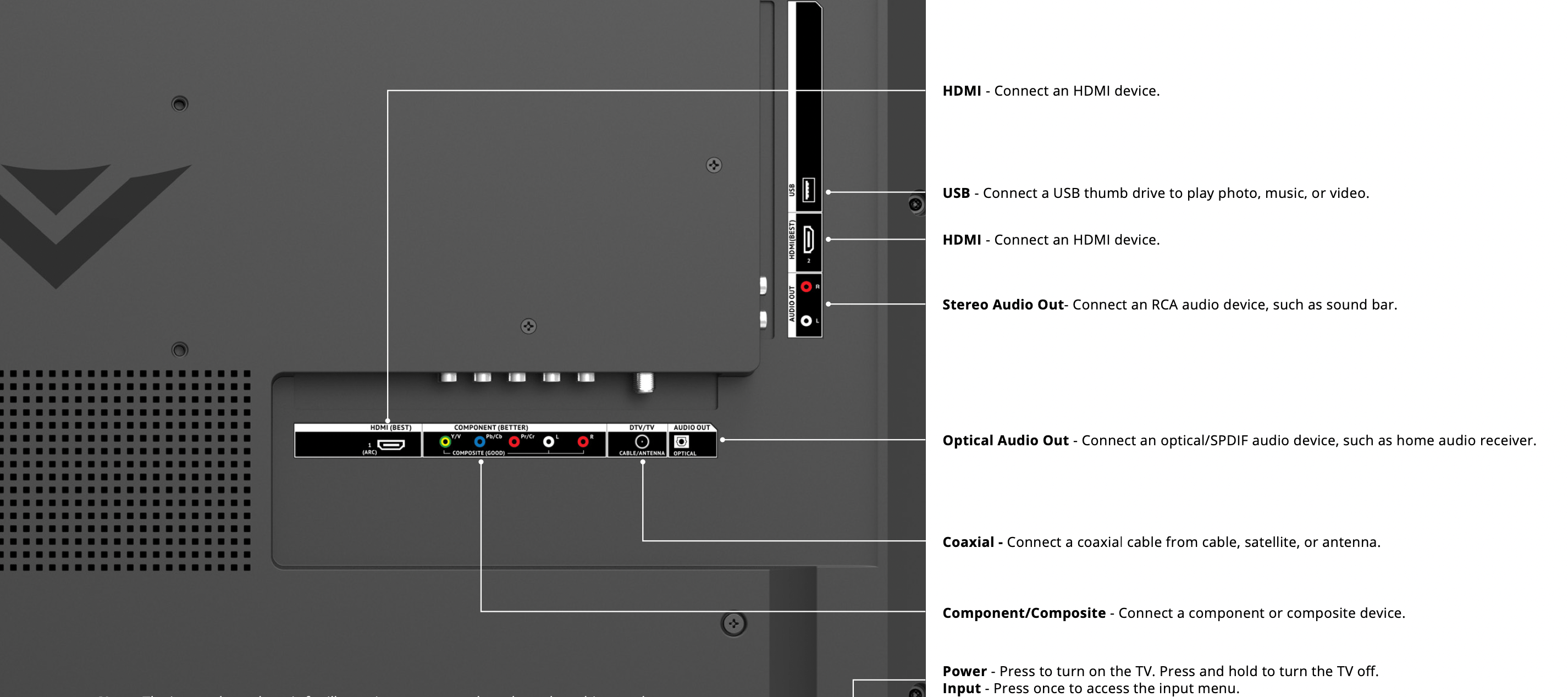
NOTE: The image shown here is for illustrative purposes only and may be subject to change. The actual number of ports and their locations may vary, depending on the model.
Using the Remote
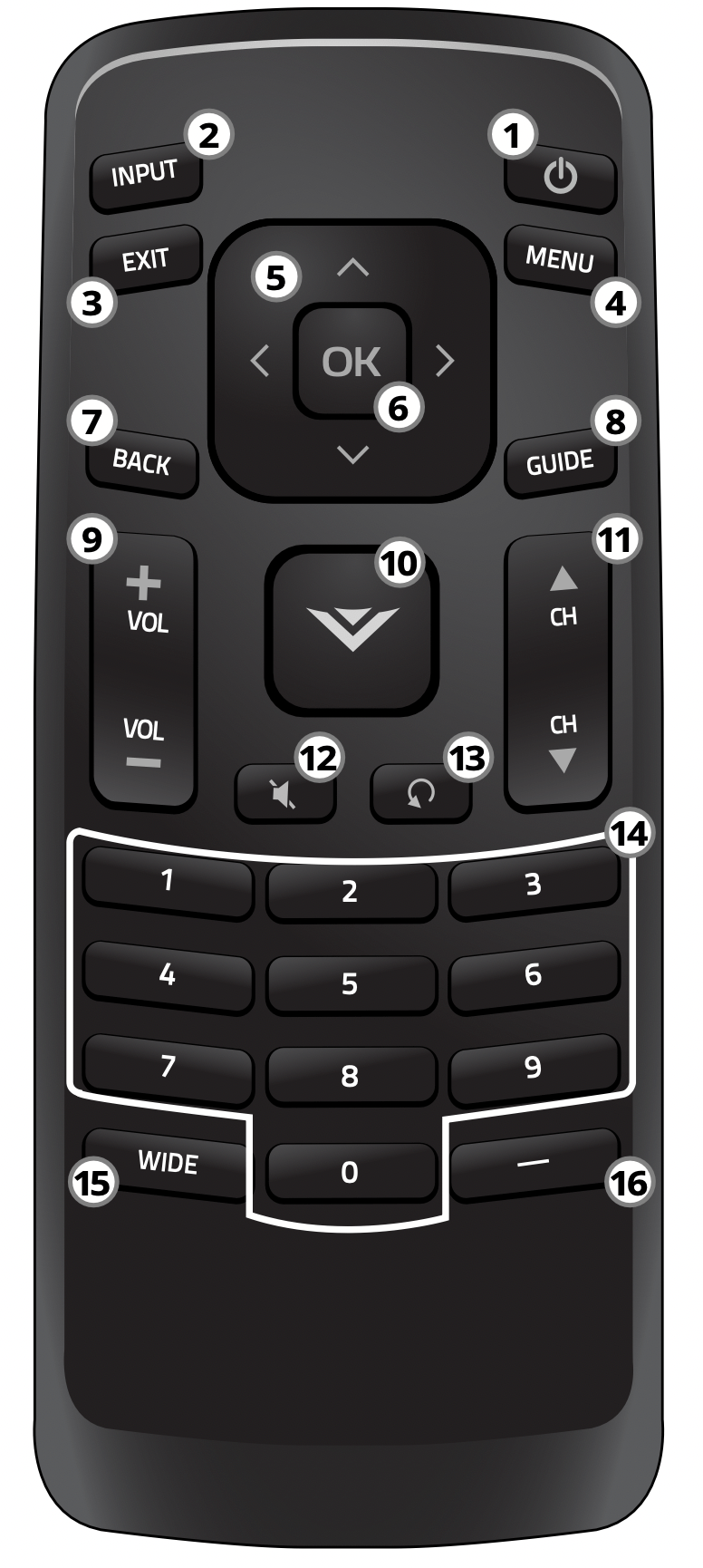
- Power - Turn TV on or Off.
- Input - Change the currently displayed input.
- Exit - Close the on-screen menu.
- Menu - Display the on-screen menu.
- Arrows - Navigate the on-screen menu.
- OK / Enter - Select the highlighted option / Confirm channel or passcode entered using the number pad.
- Back - Go to the previous on-screen menu.
- Guide - Display the info window.
- Volume Up/Down - Increase or decrease the loudness of the audio.
- V Button - Displays the multimedia menu.
- Channel Up/Down - Change the channel.
- Mute - Turn the audio on or off.
- Last - Return to the last viewed channel.
- Number Pad - Manually enter a channel.
- Wide - Change the display mode.
- Dash - Use with number pad to manually enter a digital sub-channel. (e.g. 18-4 or 18-5)
Using the On-Screen Menu
Your TV features an easy-to-use on-screen menu.
To open the on-screen menu, press the MENU button on the remote.
From this menu, you can:
- Adjust the Picture settings
- Adjust the Audio settings
- Setting the Sleep Timers
- Adjust the Channel settings
- Set up Closed Captioning
- Name Inputs
- Adjust TV settings
- Access the Guided Setup

NAVIGATING THE ON-SCREEN MENU
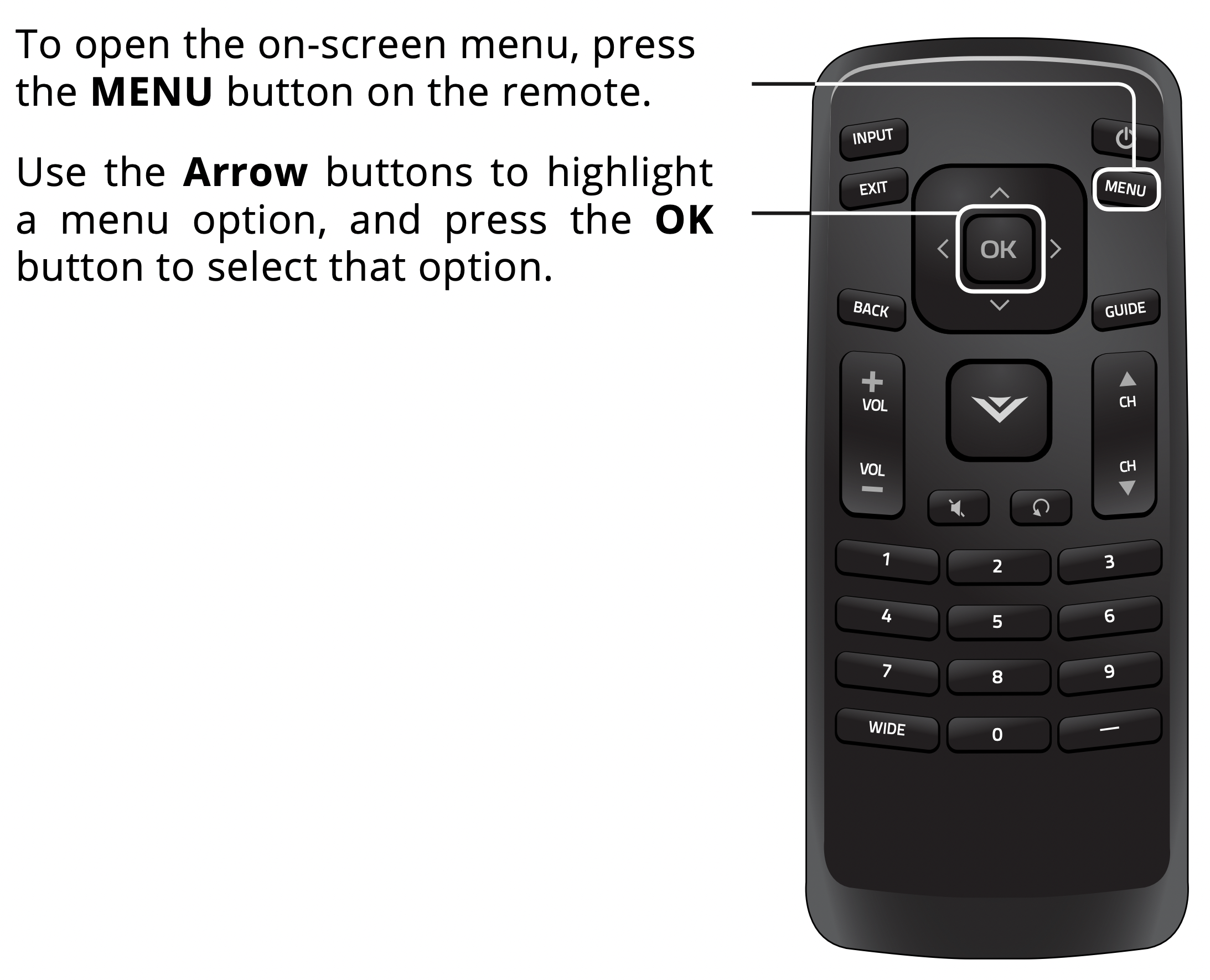
While navigating the on-screen menu, you can press the BACK button at any time to return to the previous menu screen. The EXIT button will close the on-screen menu.
CHANGING THE INPUT SOURCE
External devices such as DVD players, Blu-ray Players, and video game consoles can be connected to your TV. To use one of these devices with your TV, you must first change the input source using the Input menu.
To change the input source:
- Press the INPUT button on the remote. The Input menu is displayed.
- Use the Up/Down Arrow buttons or the INPUT button on the remote to highlight the input you wish to view and press OK. The selected input is displayed.
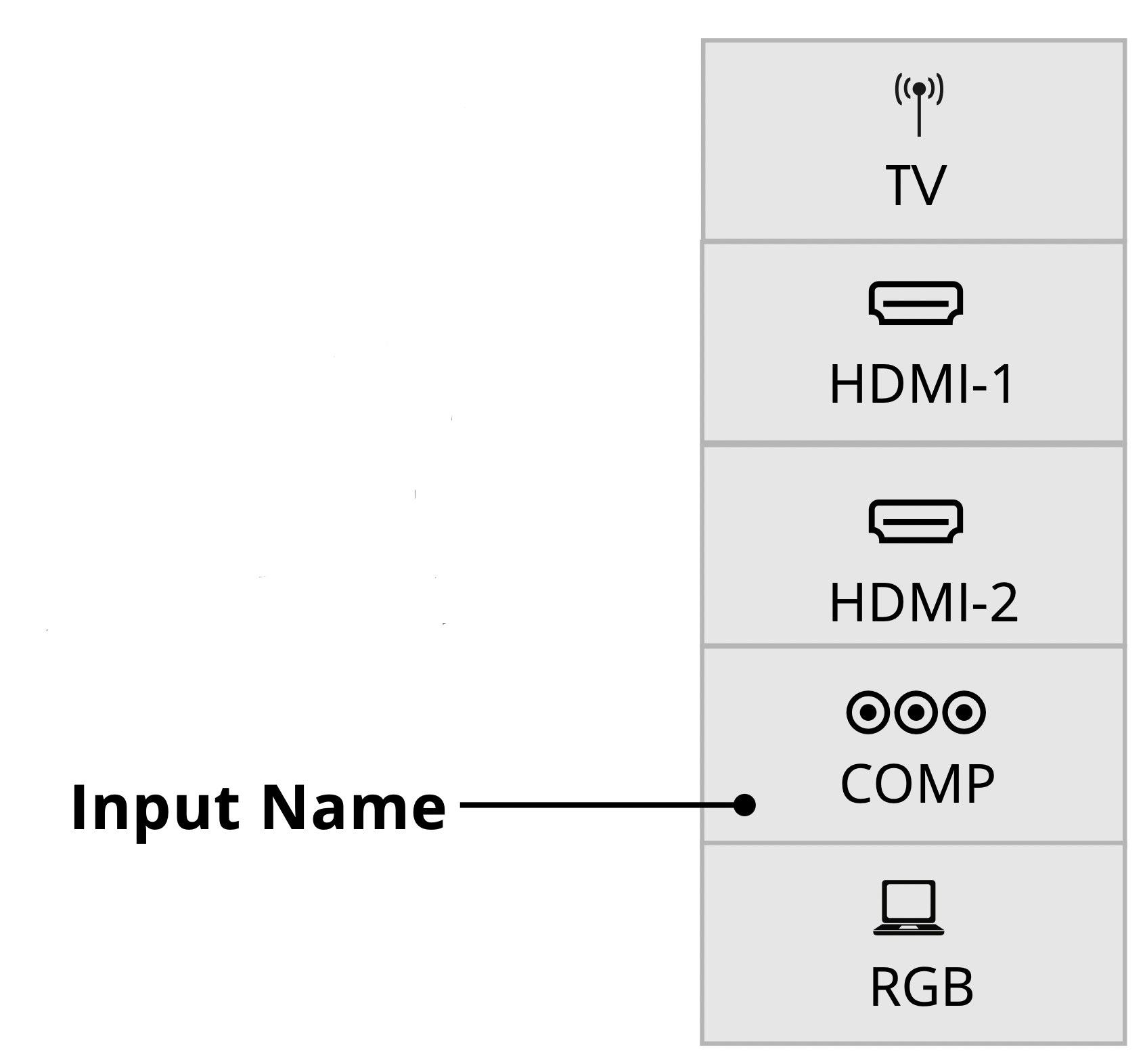
Note: Inputs may vary by TV.
You can change the input names that appear on the Input menu to make your devices easy to recognize. See Renaming Devices on the Input Menu on page 28 for more information.
CHANGING THE SCREEN ASPECT RATIO
The TV can display images in five different modes: Normal, Stretch, Panoramic, Wide, and Zoom. Each mode displays the picture differently.
Some programs have black bars on the top or sides of the picture so that the picture keeps its original shape. Examples include wide-screen movies and older television programs.
To change the screen aspect ratio:
- Press the WIDE button on the remote.
- Use the Arrow buttons to highlight the aspect ratio you wish to view and press OK.
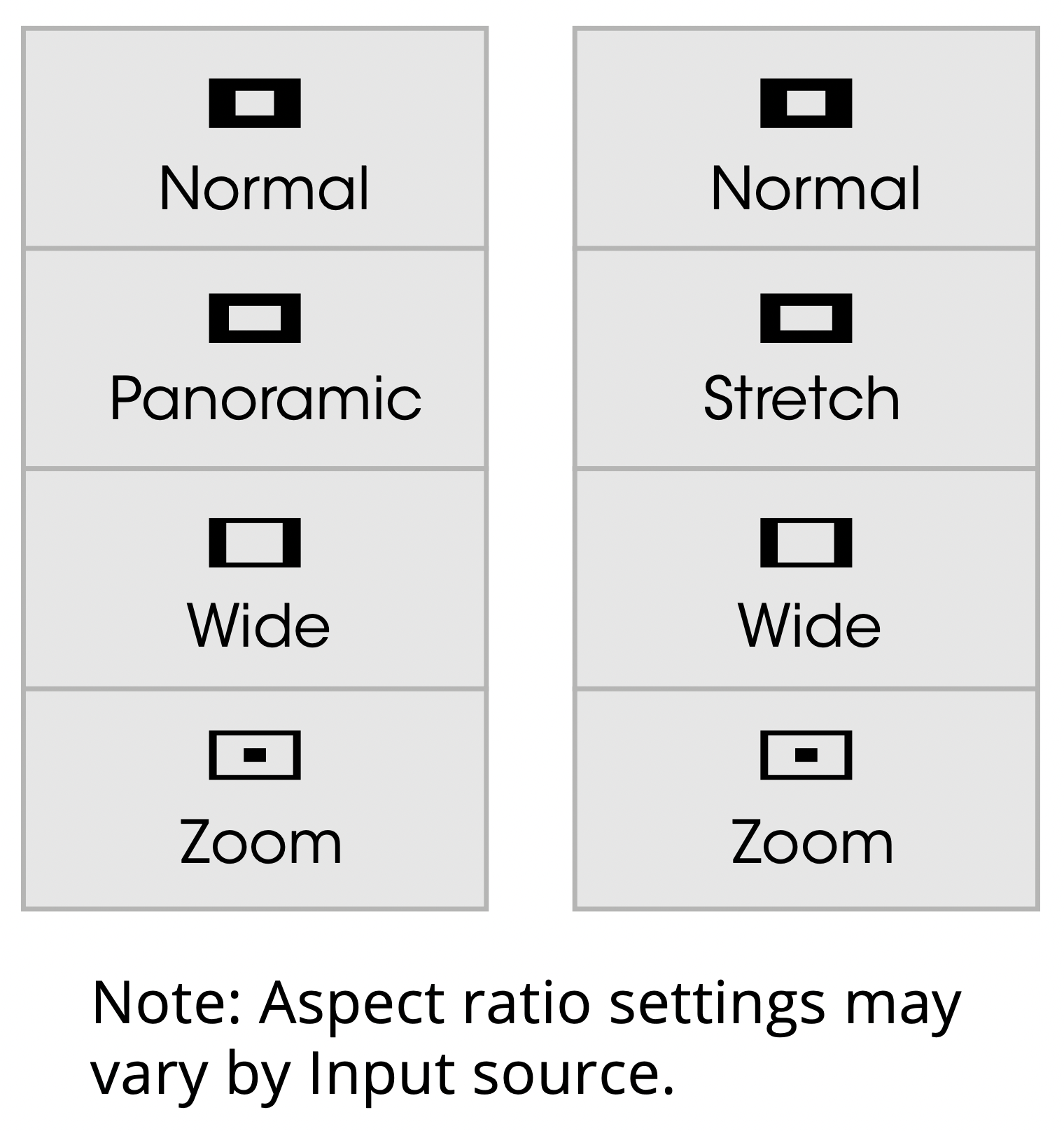
- Normal preserves the content’s original aspect ratio and size.
- Standard Definition (480i and 480p—old TV programs) - Since the 4:3 aspect ratio is not large enough to fill the TV’s screen, black bars are added to the left and right of the display image.
- 720p and 720i HD - Fills a 720p or 1080p screen.
- 1080p and 1080i HD - Fills a 720p or 1080p screen.
- Stretch expands a widescreen image to fill the screen from top to bottom and stretches it half as much from right to left. Figures appear tall and thin.
- Standard Definition - Not available.
- 720p and 720i HD - If you are watching widescreen 1.85:1 content, the image will fill the screen. With 2.35:1 widescreen content, one-sixth of the image is cut off by the left and right sides of the screen.
- 1080p and 1080i - Not available.
- Panoramic stretches a 4:3 aspect ratio picture to the left and right edges of the screen. The center of the image is not stretched, but the sides of the image are extremely stretched. If you are watching widescreen (1.85:1 or 2.35:1) content with black bars on the top and bottom, the black bars will still appear on the top and bottom of the display image.
- Standard Definition (480i and 480p) - Fills the screen from the left to right edges.
- 720p and 720i - Not available.
- 1080p and 1080i - Not available.
- Wide stretches a 4:3 aspect ratio picture to the edges of the screen. Since the picture is being stretched, the display image may appear distorted—figures appear short and fat. If the program is already formatted for widescreen viewing (1.85:1 or 2.35:1), then black bars will appear on the top and bottom of the display image.
- Zoom expands images evenly in all directions (33% taller and 33% wider) with black bars to fit the screen. A 720p image will fill a 1080p screen.
- Standard Definition - Not available.
- 720p and 720i HD - Fills a 1080p screen
- 1080p and 1080i - Not available.
Tip: The aspect ratio cannot be changed for Ultra HD content or for any video content on HDMI-5.
ADJUSTING THE PICTURE SETTINGS
Your TV display can be adjusted to suit your preferences and viewing conditions.
If you’ve changes to the settings for a picture mode, an asterisks appears after its name (see Saving a Custom Picture Mode on page 16).
To adjust the picture settings:
- Press the MENU button on the remote. The on-screen menu is displayed.
- Use the Arrow buttons on the remote to highlight Picture and press OK. The PICTURE menu is displayed.
- Use the Arrow buttons on the remote to highlight Picture Mode, then use the Left/Right Arrow buttons to change the picture mode:
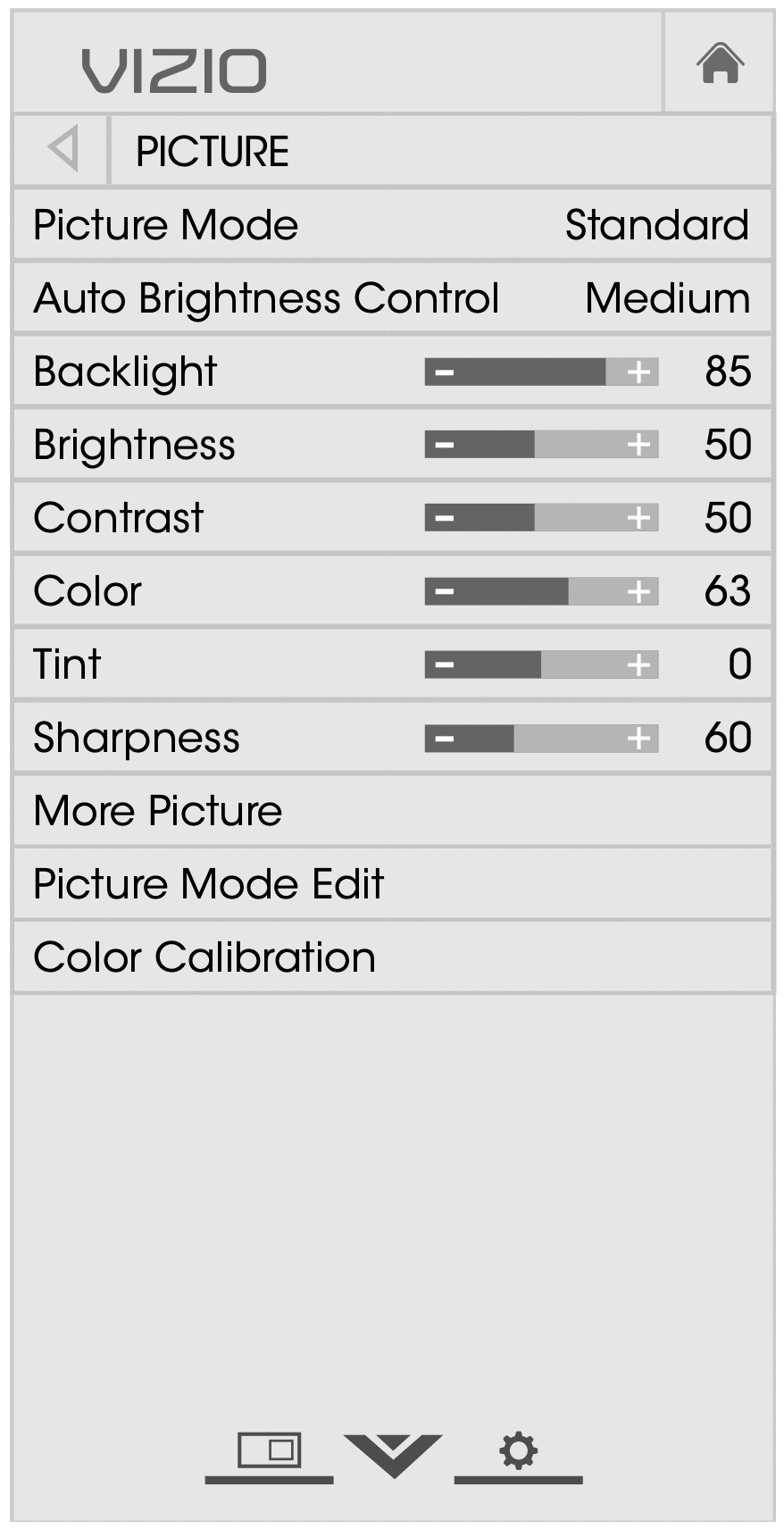
Standard mode sets the picture settings to the default settings.
Calibrated mode sets the picture settings to values ideal for watching TV in a brightly-lit room.
Calibrated Dark mode sets the picture settings to values ideal for watching TV in a dark room.
See other models: M55-F0 P659-G1 D55x-G1 V555-G1 D32hn-E4
Vivid mode sets the picture settings to values that produce a brighter, more vivid picture.
Game mode reduces throughput delays and optimizes the picture settings for displaying game console output.
Computer mode optimizes the picture settings for displaying computer output. - To manually change each of the picture settings, use the Up/ Down Arrow buttons on the remote to highlight that picture setting, then use the Left/Right Arrow buttons to adjust the Wide Zoom Normal Panoramic setting:
Auto Brightness Control - The auto brightness control detects the light levels in the room and automatically adjusts the backlight for the best picture. Select Off, Low, Medium, or Exit 2D 3D High.
Backlight - Adjusts the LED brightness to affect the overall ABC brilliance of the picture. Backlight cannot be adjusted when starting from some picture modes.
Contrast - Adjusts the white level of the picture. When this setting is too low, the picture may appear dark. When this setting is too high, the picture may appear faded or washed out. If the setting is too high or too low, detail may be difficult Network Settings Help to distinguish in dark or bright areas of the picture.
Color - Adjusts the intensity of the picture colors.
Tint - Adjusts the hue of the picture. This setting is useful in adjusting the flesh tones in the picture. If flesh appears too orange, reduce the level of color before adjusting tint.
Sharpness - Adjusts the edge sharpness of picture elements. It can be used to sharpen non-HD (high definition) content; however, it will not produce detail that does not otherwise exist. - When you have finished adjusting the picture settings, press the EXIT button on the remote.
Adjusting More Picture Settings
To adjust more picture settings:

-
From the PICTURE menu, use the Arrow buttons to highlight More Picture, and then press OK.
-
Use the Arrow buttons to highlight the setting you wish to adjust, then press the Left/ Right Arrow buttons to change the setting:
-
Color Temperature - See Adjusting the Color Temperature on page 15.
-
Black Detail - Adjusts the average brightness of the picture to compensate for large areas of brightness. Select Off, Low, Medium, or High.
-
Backlight Control - Dynamically improves the contrast ration of the picture by adusting the backlight. Select Off or On.
-
Reduce Signal Noise - Diminishes artifacts in the image caused by the digitizing of image motion content. Select Off, Low, Medium, or High.
-
Game Low Latency - Select On to reduce video delay (lag) when gaming.
-
Picture Size & Position - Highlight Picture Size & Position and press OK. The PICTURE SIZE & POSITION menu is displayed
-
Picture Size: Increase or decrease the vertical and horizontal size of the displayed picture. Use the Left/ Right Arrow buttons to adjust the horizontal size of the displayed picture. Use the Up/Down Arrow buttons to adjust the vertical size of the displayed picture. Press the OK button when you are finished.
-
Picture Position: Adjust the vertical and horizontal positions of the picture to ensure the image is centered and completely fills the screen. Use the Left/Right Arrow buttons to adjust the horizontal position of the displayed picture. Use the Up/Down Arrow buttons to adjust the vertical position of the displayed picture. Press the OK button when you are finished.
-
Film Mode - Optimizes the picture for watching film. Select Input Auto or Off.
-
Gamma - Set the shape of the Gamma curve. Use lower Gamma values for bright room conditions, and higher values when it’s dark.
-
-
When you have finished adjusting More Picture Settings, press the EXIT button on the remote.
Adjusting the Color Temperature
Adjusting the color temperature changes the white balance of the picture.

To adjust the color temperature:
- From the MORE PICTURE menu, use the Arrow buttons to highlight Color Temperature, and then press OK.
- Use the Arrow buttons on the remote to highlight a color temperature preset and then press OK.
Normal is optimized for television viewing.
Cool produces a blue-hued picture.
Computer optimizes the picture for use as a PC monitor. - When you have finished adusting the color temperature, press the EXIT button on the remote.
Adjusting the Picture Mode Edit Settings
Picture Mode Edit Settings allow you to make precise adjustments to the picture and to create picture modes to save groups of picture settings.
To adjust the Picture Mode Edit settings:
- From the PICTURE menu, use the Arrow buttons to highlight Picture Mode Edit, and then press OK. The PICTURE MODE EDIT menu is displayed.

- Use the Arrow buttons to highlight the setting you wish to adjust, then press OK to change the setting:

- Save Picture Mode - Save a custom picture mode.
- Lock Picture Mode - Prevent changes to custom picture modes.
- Unlock Picture Mode - Allow changes to custom picture modes. (Available after a custom picture mode is locked)
- Delete Picture Mode - Delete a custom picture mode. Inputs assigned to that custom picture mode will be set to Calibrated picture mode. (Available after a custom picture mode is saved)
- Reset Picture Mode † - Reset the picture mode settings to factory default values.
Saving a Custom Picture Mode
Custom picture modes allow you to save a group of custom settings for various viewing conditions and video sources.
- Changes made while on any preset picture mode will add an asterisk on the top right corner of the preset mode.
- The custom picture mode is not automatically saved.
To save a custom picture mode:
- From the PICTURE MODE EDIT menu, use the Arrow buttons to highlight Save Picture Mode, and then press OK. The SAVE PICTURE MODE menu is displayed.
- Use either the on-screen keyboard or keyboard on your remote control to enter a name for your custom picture mode.
- Highlight Save and press OK.
- Press the EXIT button to exit the menu screens.
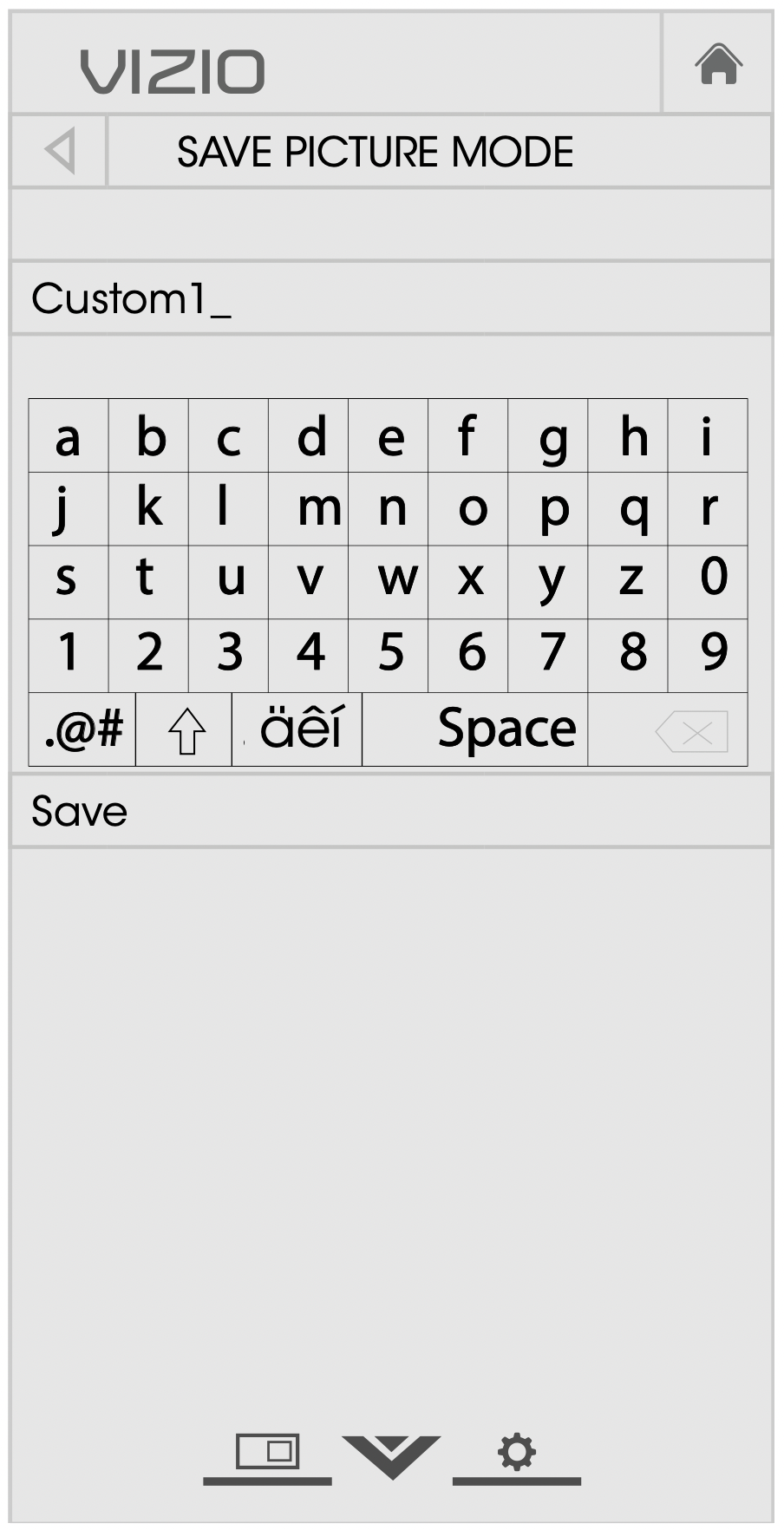
Locking/Unlocking a Custom Picture Mode
Custom picture modes can be locked/unlocked with a unique PIN to prevent accidental changes to their settings.
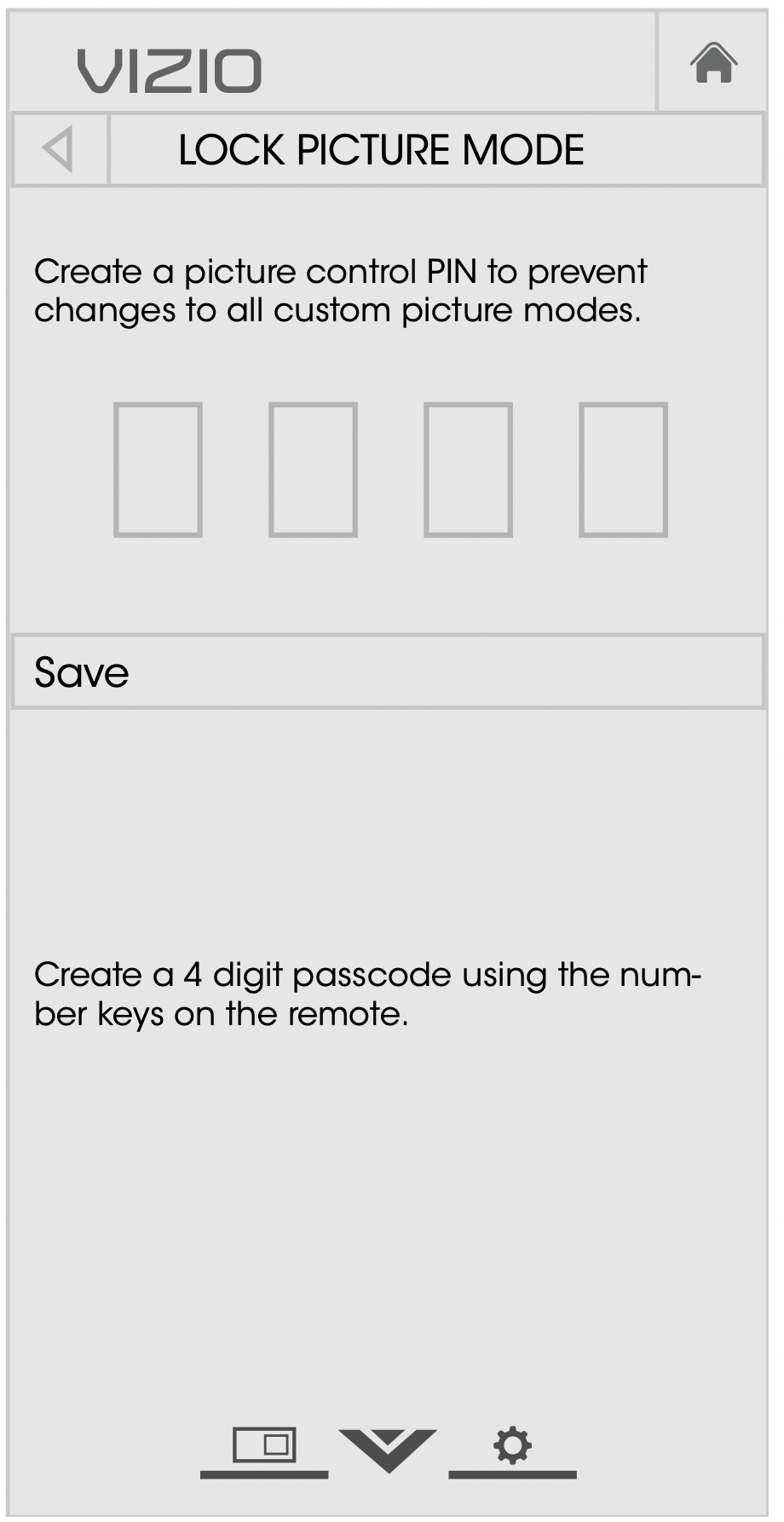
To lock all custom picture modes:
- From the PICTURE MODE EDIT menu, use the Arrow buttons to highlight Lock Picture Mode, and then press OK. The LOCK PICTURE MODE menu is displayed.
- Use the Number Pad on your remote to enter a unique 4-digit PIN.
- Use the Number Pad on your remote to enter a unique 4-digit PIN.
- Press the EXIT button to exit the menu screens.ABC
To unlock all custom picture modes:
- From the PICTURE MODE EDIT menu, use the Arrow buttons to highlight Unlock Picture Picture Mode, and then press OK. The UNLOCK PICTURE MODE menu is displayed.
- Use the Number Pad on your remote to enter your 4-digit PIN.
- Make any desired changes to the picture modes.
- Relock the picture modes, if desired. You must create a new 4-digit PIN.
- Press the EXIT button to exit the menu screens.
Deleting a Custom Picture Mode
Custom picture modes that are no longer needed can be deleted.
Inputs assigned to a deleted custom picture mode become assigned to the Calibrated picture mode.
To delete a custom picture mode:
- From the PICTURE MODE EDIT menu, use the Arrow buttons to highlight Delete Picture Mode, and then press OK. The DELETE PICTURE MODE window is displayed.
- Use the Left/Right Arrow buttons to highlight Delete and press OK.
- Press the EXIT button to exit the menu screens.
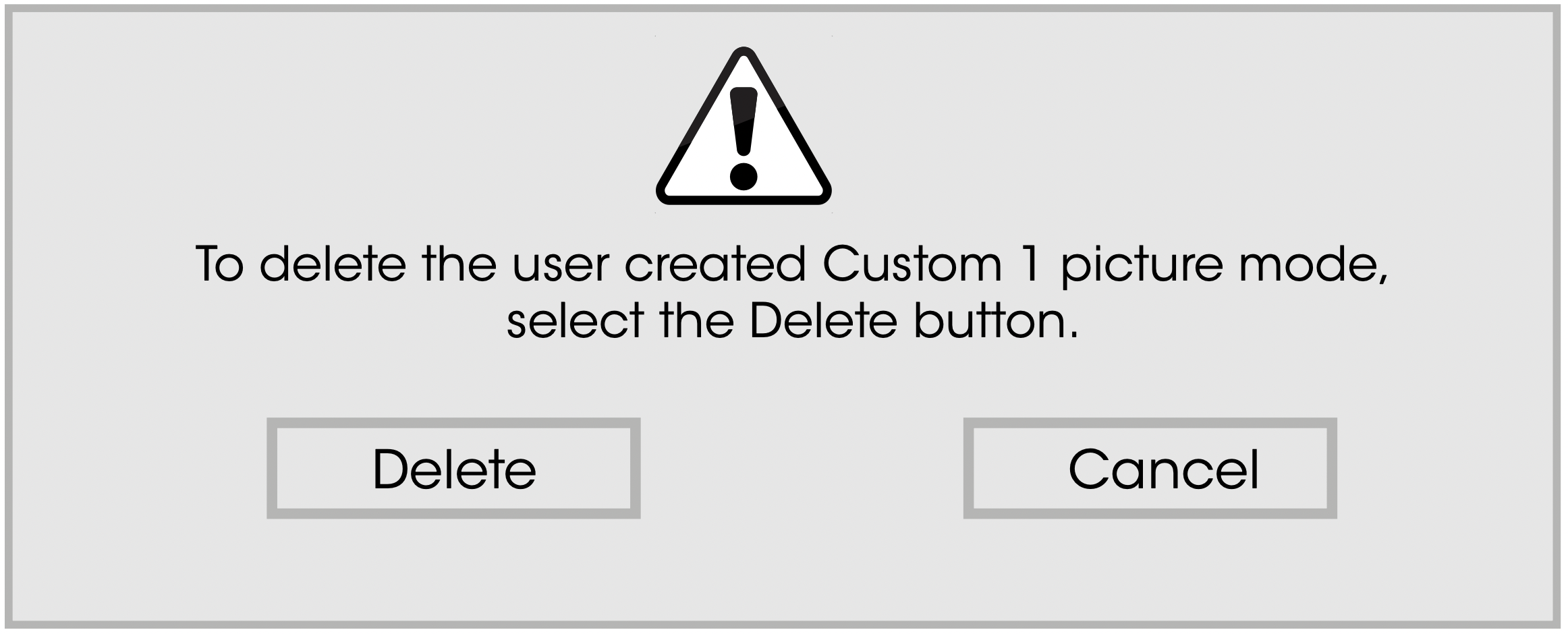
Resetting a Picture Mode
A preset picture mode that has been edited can be restored to the factory default settings.
To reset a customized preset picture mode:
- From the PICTURE MODE EDIT menu, use the Arrow buttons to highlight Reset Picture Mode, and then press OK. The RESET PICTURE MODE window is displayed.
- Use the Left/Right Arrow buttons to highlight Reset and press OK.
- Press the EXIT button to exit the menu screens.

Adjusting the Color Tuner Settings
The Color Tuner settings allow you to adjust the HSB color and 11 point white balance, turn color channels off for testing, and display color bar, flat, and ramp test patterns.
CAUTION: The Color Tuner, 11 Point White Balance, and test patterns allow technicians to manually calibrate the TV. Calibration requires specialized training, an input with precisely set colors, and a specialized light meter.
To adjust the HSB color settings:
- From the COLOR CALIBRATION menu, use the Arrow buttons to highlight Color Tuner, and then press OK. The Color Tuner menu is displayed.

- Use the Arrow buttons on the remote to highlight the Hue, Saturation, Brightness, Offset, or Gain of the color you wish to adjust. Press the OK button.
- Use the Left/Right Arrow buttons to adjust the value. When you are finished press the OK button to save the setting.
- When you are finished adjusting the color tuner settings, press the EXIT button.
To turn color channels off and on:
- From the COLOR CALIBRATION menu, use the Arrow buttons to highlight Color Tuner, and then press OK. The Color Tuner menu is displayed.

- Use the Arrow buttons on the remote to highlight Red, Green, or Blue.
- Press the OK button to turn the color channel off or on. An X appears over a color channel that has been turned off.
- Use the Arrow buttons to highlight another color channel to turn off or on. Only two color channels can be turned off at the same time.
- When you are finished with the color channels, press the EXIT button.
To adjust the 11 Point White Balance settings:
- From the Color Tuner menu, use the Arrow buttons to highlight Color Tuner, and then press the Left/Right Arrow buttons until the 11 Point White Balance menu is displayed.

- Use the Arrow buttons on the remote to highlight the Gain and Color values you wish to adjust. Press the OK button and use the Left/Right Arrow buttons to adjust the value. When you are finished, press the OK button to save the setting.
- When you are finished, press the EXIT button.
To show or hide the SMPTE Test Pattern:
- From the Color Tuner menu, use the Arrow buttons to highlight Color Tuner, and then press the Left/Right Arrow buttons until the SMPTE Test Pattern menu is displayed.

- Use the Arrow buttons on the remote to highlight Off. Use the Left/Right Arrow buttons to highlight On to show the SMPTE Pattern.
OR
To hide the SMPTE Test Pattern, use the Left/Right Arrow buttons to highlight Off. - When you are finished, press the EXIT button.
To show or hide the Flat Test Pattern:
- From the Color Tuner menu, use the Arrow buttons to highlight Color Tuner, and then press the Left/Right Arrow buttons until the Flat Test Pattern menu is displayed.

- Use the Arrow buttons on the remote to highlight Off. Use the Left/Right Arrow buttons to select the percentage brightness for the flat test pattern. Selecting a percentage immediately shows the flat pattern at that brightness.
OR
To disable the Flat Test Pattern, use the Left/Right Arrow buttons to highlight Off. - When you are finished, press the EXIT button.
To show or hide the Ramp Test Pattern:
- From the Color Tuner menu, use the Arrow buttons to highlight Color Tuner, and then press the Left/Right Arrow buttons until the Ramp Test Pattern menu is displayed.

- Use the Arrow buttons on the remote to highlight Off. Use the Left/Right Arrow buttons to select the color for the ramp test pattern. Selecting a color immediately shows that color ramp.
OR
To hide the Ramp Test Pattern, use the Left/Right Arrow buttons to highlight Off. - When you are finished, press the EXIT button.
ADJUSTING THE AUDIO SETTINGS
To adjust the audio settings:
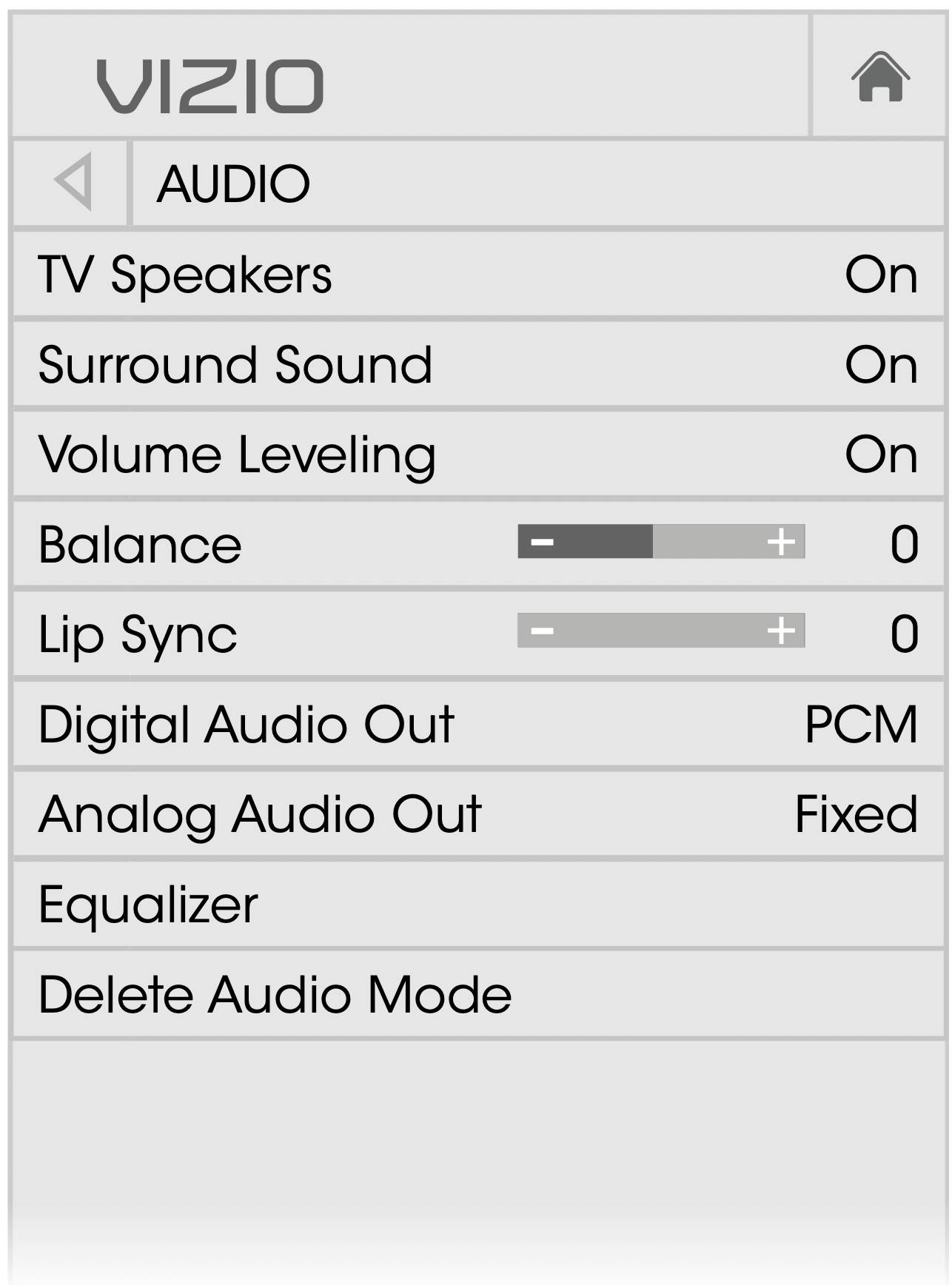
- Press the MENU button on the remote. The on-screen menu is displayed.
- Use the Arrow buttons on the remote to highlight Audio and press OK. The AUDIO menu is displayed.
- Use the Arrow buttons to highlight the setting you wish to adjust, then press Left/ Right Arrow buttons to change the setting:
TV Speakers - Turns the built-in speakers On or Off.
Surround Sound - Surround sound uses DTS TruSurround to deliver an immersive surround sound experience from the TV’s internal speakers. TruSurround completes the entertainment experience by providing deep, rich bass and by delivering crisp details and clear, intelligible dialog. Select On or Off.
Volume Leveling - Volume leveling uses DTS TruVolume to maintain consistent volume levels during transitions between program content, AV formats, and input sources. Select On or Off. In a few cases, volume leveling may artificially suppress volume increases, making it difficult to hear dialog or flattening sudden noises. If this occurs, turn volume leveling off.
Balance - Adjusts the loudness of the audio output from the left and right speakers.
Lip Sync - Adjusts the synchronization between the display image and the accompanying audio track.
Digital Audio Out - Changes the type of processing for digital audio out and HDMI ARC output when connected to a home theater audio system. Select PCM or Bitstream.
Analog Audio Out - Sets the volume control properties for the RCA connector when connected to a home theater audio system. Select Variable if you are controlling the volume with the TV’s volume controls, or select Fixed if an external audio device (sound bar or AV receiver) will control the volume.
Equalizer - Adjusts the boost or attenuation of different frequencies using either preset or custom settings. See Changing the Equalizer Settings on page 20.
Delete Audio Mode - Deletes a custom audio mode created using the Equalizer Settings. See Deleting the Custom Audio Mode on page 21. - When you have finished adjusting the audio settings, press the EXIT button on the remote.
Changing the Equalizer Settings
The graphic equalizer has several pre-set modes and allows you to create one custom mode.
To select a pre-set audio mode:
- Press the MENU button on the remote. The on-screen menu is displayed.
- Use the Arrow buttons on the remote to highlight Audio and press OK. The AUDIO menu is displayed.
- Use the Arrow buttons to highlight Equalizer and press OK. The Audio Mode and equalizer settings screen appears.
- Use the Left and Right Arrow buttons to select an audio mode.
The equalizer bars change to reflect the mode. - Press the EXIT button on the remote.
To create, modify, or replace the single custom equalizer setting:
- Press the MENU button on the remote. The on-screen menu is displayed.
- Use the Arrow buttons on the remote to highlight Audio and press OK. The AUDIO menu is displayed.
- Use the Arrow buttons to highlight Equalizer and press OK. The Audio Mode and equalizer settings screen appears.
- Use the Left and Right Arrow buttons to select any audio mode as a starting point.
- Use the Arrow buttons to highlight a frequency and then press OK.
- Use the Up and Down Arrow buttons to adjust the boost (up) and attenuation (down) for the frequency.
- Use the Left and Right Arrow buttons to select another frequency, if desired, and adjust it.
- Press the EXIT button on the remote.
Deleting the Custom Audio Mode
To delete the custom audio mode that has been created:
- Press the MENU button on the remote. The on-screen menu is displayed.
- Use the Arrow buttons on the remote to highlight Audio and press OK. The AUDIO menu is displayed.
- Use the Arrow buttons to highlight Delete Audio Mode and press OK. The TV displays, “To delete the user created custom audio mode, select the Delete button.”
- Highlight Delete and press OK.
- Press the EXIT button on the remote.
SETTING TIMERS
Setting the Sleep Timer
When activated, the TV’s sleep timer will turn the TV off after a set period of time.
- Press the MENU button on the remote. The on-screen menu is displayed.
- Use the Arrow buttons on the remote to highlight Timers and press OK. The TIMERS menu is displayed.
- Use the Left/Right Arrow buttons on the remote to highlight the period of time after which you want the TV to go to sleep: 30, 60, 90, 120, or 180 minutes. If you don’t want the sleep timer to activate, change the setting to Off.
- When you have finished setting the sleep timer, press the EXIT button on the remote.
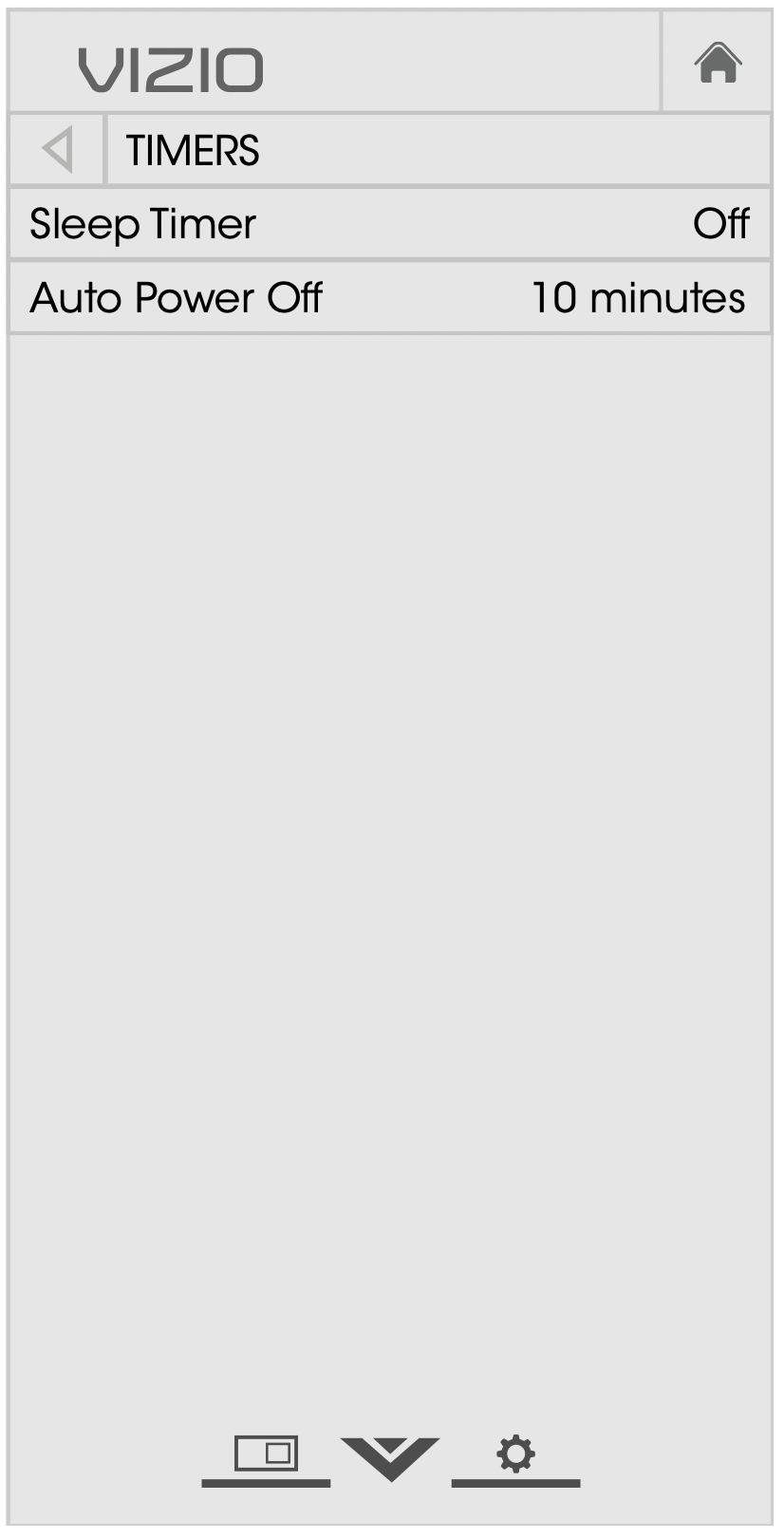
Setting the Auto Power Off Feature
To help save energy, your TV is set by default to turn off after 10 minutes without a video or audio signal. This feature can be deactivated.
To set the Auto Power Off feature:
- From the TIMERS menu, use the Up/Down Arrow buttons on the remote to highlight Auto Power Off.
- Wide Use the Zoom Left/Right Normal Panoramic Arrow buttons on the remote to change whether the TV will turn off. If you don’t want the TV to turn off when there is no signal, change the setting to Off. Otherwise, select 10 minutes.
- When you have finished setting the auto power off time, press the EXIT button on the remote.
SETTING UP CHANNELS
You can use the TV’s Channels menu to:
- Select a Channel Source
- Find Channels
- Perform a Partial Channel Scan
- Manually Add Channels
- Select channels to skip
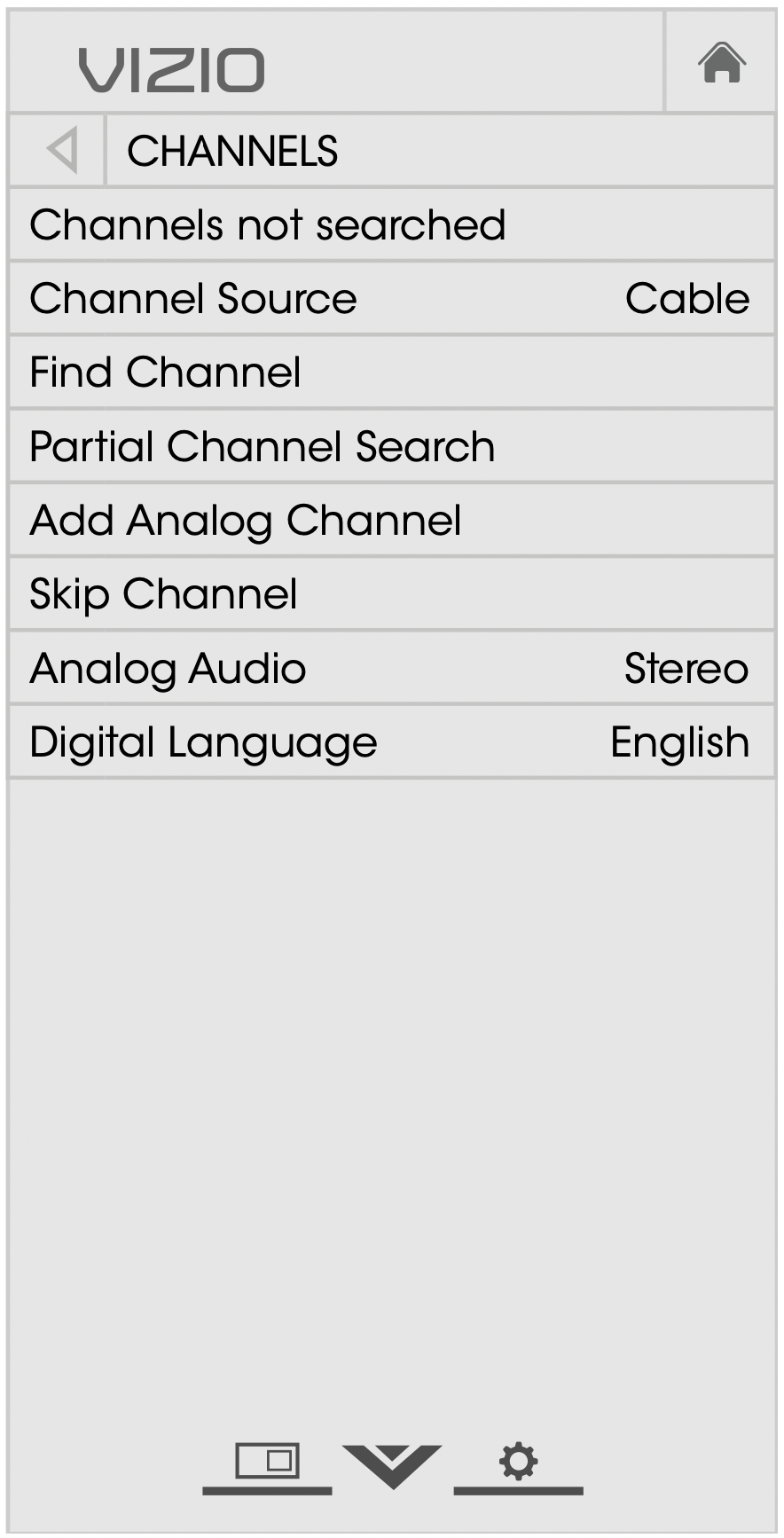
Selecting a Channel Source
Select the type of tuner input you will be using. You can select either Antenna (Over-the-air) or Cable (Out-of-the-wall) connections.
- From the CHANNELS menu, highlight Channel Source and press OK. The CHANNEL SOURCE menu displays.
- Wide Highlight Zoom Antenna or Cable and press OK. Press EXIT.
Scanning for Channels
The TV may need to scan for channels before it can display programs Exit 2D 3D and their associated information. A channel scan is required for free over-the-air channels (using an antenna) and cable channels ABC from an out-of-the-wall connection (without a cable box). Moving the TV to an area with different channels requires the TV to scan for channels Input again.
To perform an Auto Channel Scan:
- Sleep From the CHANNELS menu, highlight Picture Find Audio Channels, and press OK. The auto channel scan
- Wait until the channel scan is Settings Help 100% complete. Highlight Done and press OK.
- Press the EXIT button on the remote.
If the channel scan is cancelled, the channels that were already discovered are retained. A new channel scan will clear all channels.
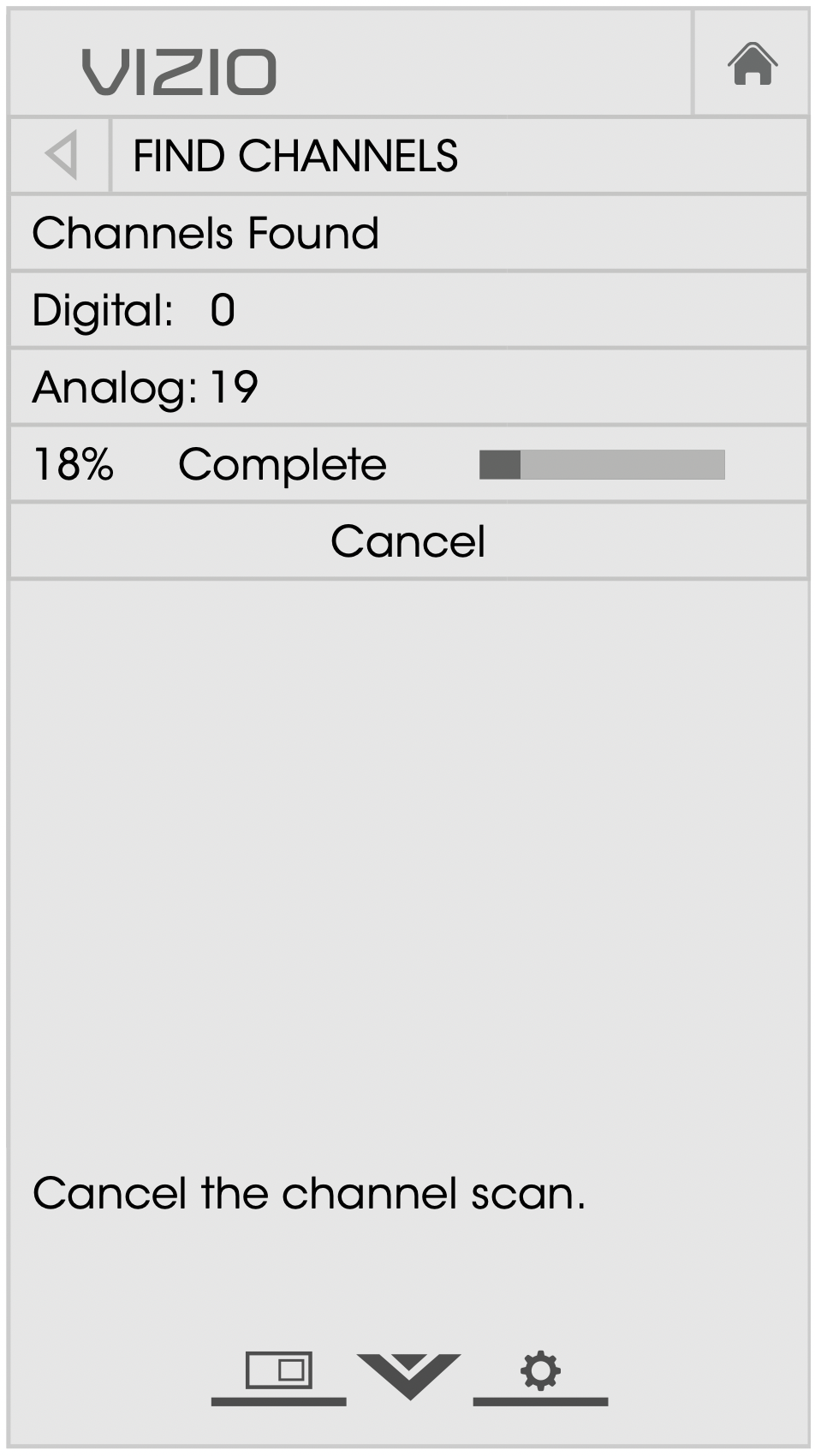
Adding New Channels
Occasionally, you may need to add a new range of channels or add a new analog channel. You can do this by using the Partial Channel Search and Add Analog Channel options. This is quicker than scanning all possible channels.
To add a range of new channels:
- From the CHANNELS menu, highlight Partial Channel Search, and press OK. The PARTIAL CHANNEL SEARCH menu is displayed.
- Highlight Scan Mode and select the type of channel you are adding: Analog, Digital, or Analog/Digital.
- Highlight From Channel and enter the channel where you want to begin the scan. (Use the Left Arrow button to backspace. Use the Number Pad on the remote to enter the channel.)
- Highlight To Channel and enter the channel where you want to end the scan. (Use the Left Arrow button to backspace. Use the Number Pad on the remote to enter the channel.)
- Exit Highlight Start and press OK. The partial channel search begins.
- Wait until the partial channel search is 100% complete. Highlight Done and press OK.
To add a single new analog channel:
- From the CHANNELS menu, highlight Add Analog Channel and press OK. The ADD ANALOG CHANNEL menu is displayed.
- Highlight Enter Channel # and use the Number Pad on the remote to enter the number of the channel you are adding.
- Highlight Add Channel and press OK. The TV scans for the channel.
- When the TV is done scanning for the channel, press the EXIT button on the remote.
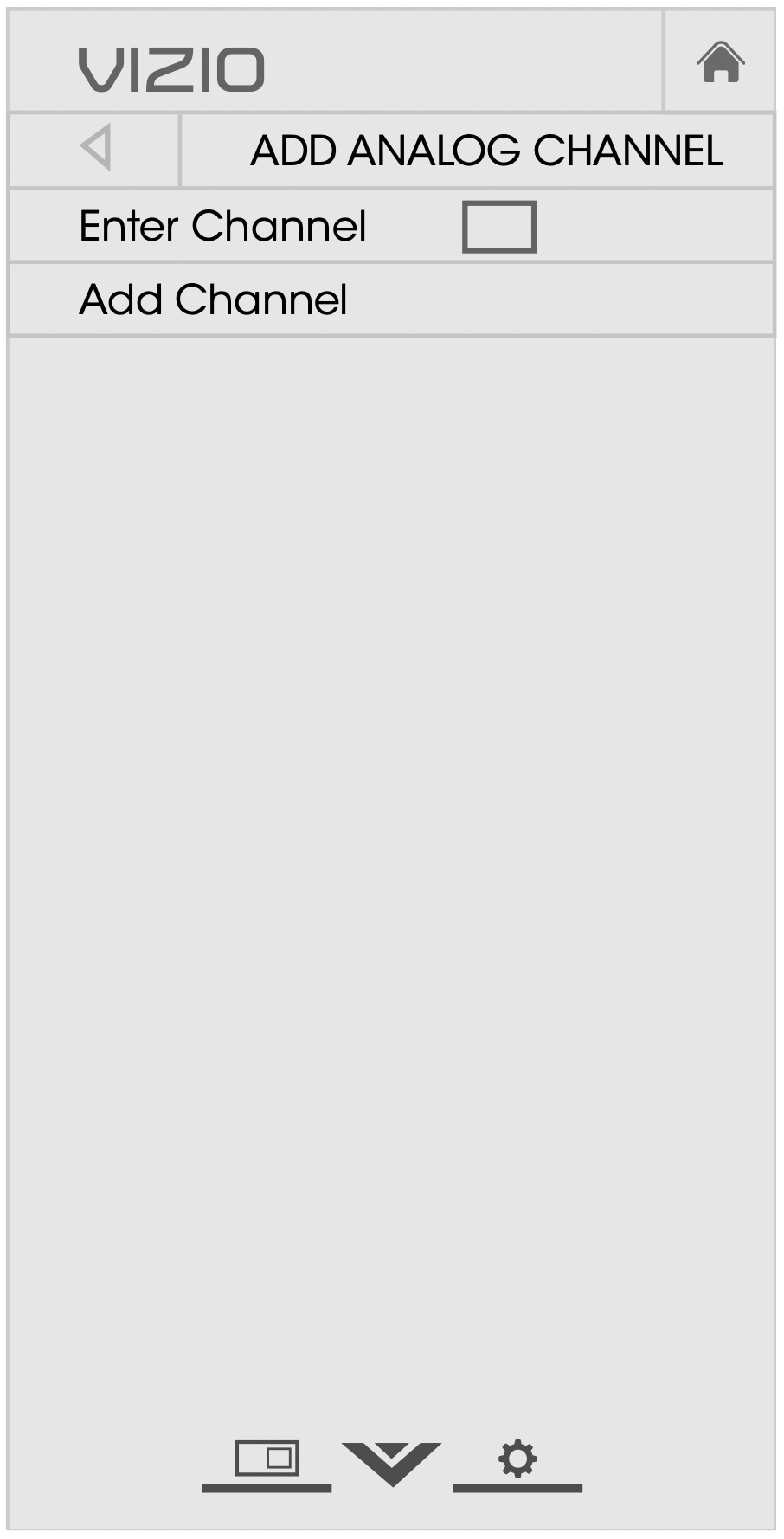
Skipping Channels
After a channel scan is completed, you may find that some channels are too weak to watch comfortably. There may also be some channels you do not want to view. You can remove these channels from the TV’s memory with the Skip Channel feature.
CAUTION: Channels that have been removed with the Skip Channel feature can still be viewed if the channel is entered using the Number Pad. If you wish to completely block a channel from being viewed, use the parental controls. See Locking and Unlocking Channels on page 30.
To remove a channel:
- From the CHANNELS menu, Sleep highlight Skip Channel, and press OK. The SKIP CHANNEL menu is displayed.
- For each channel you wish to remove, use the Up/Down Arrow buttons on the remote to highlight the channel and press OK. A
 appears to the right of each channel you select.
appears to the right of each channel you select. - When you have selected all of the channels you wish to remove, press the EXIT button on the remote.
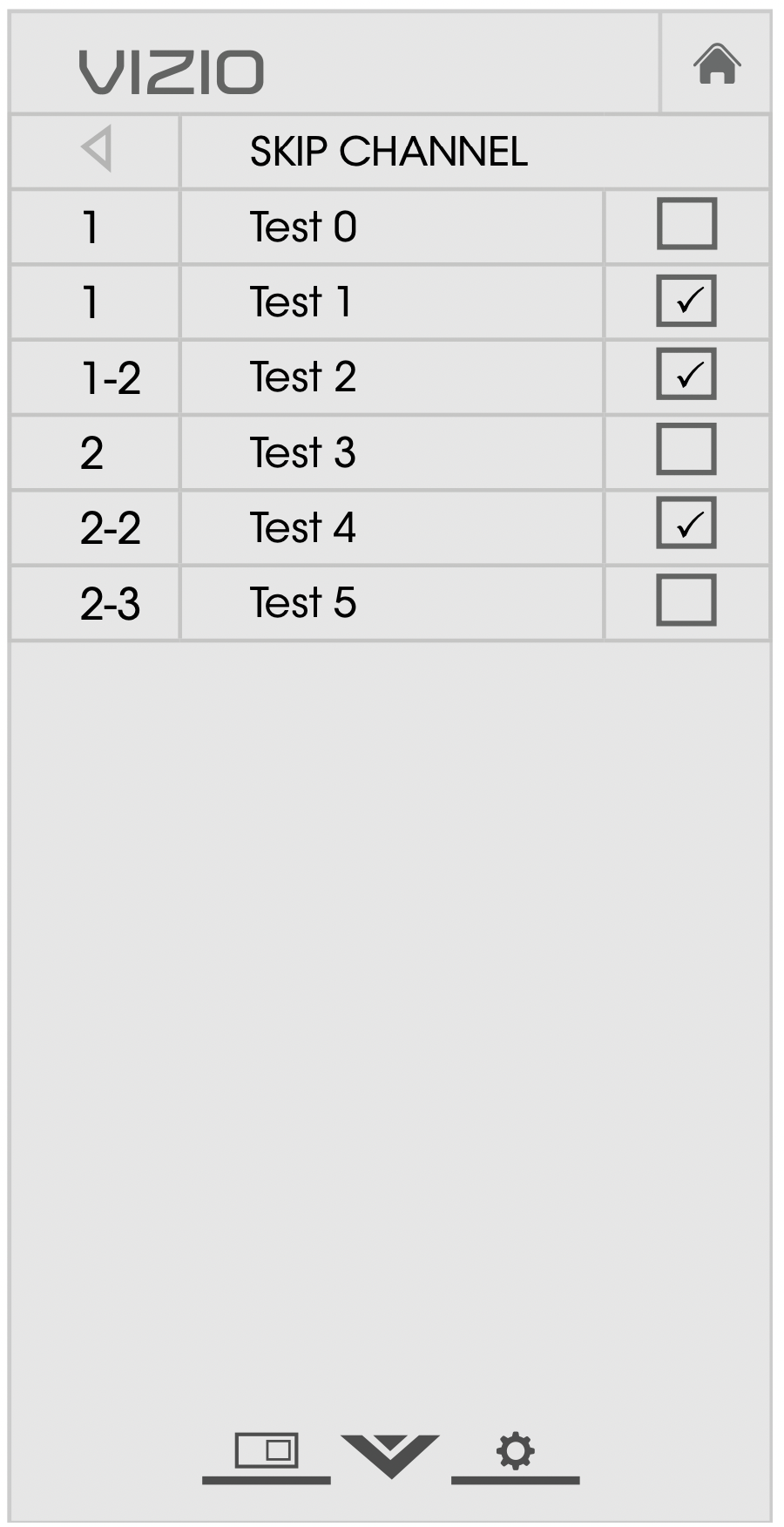
Using the USB Media Player
Using the USB Media Player
The USB Media Player allows you to connect a USB thumb drive to your TV to view photos
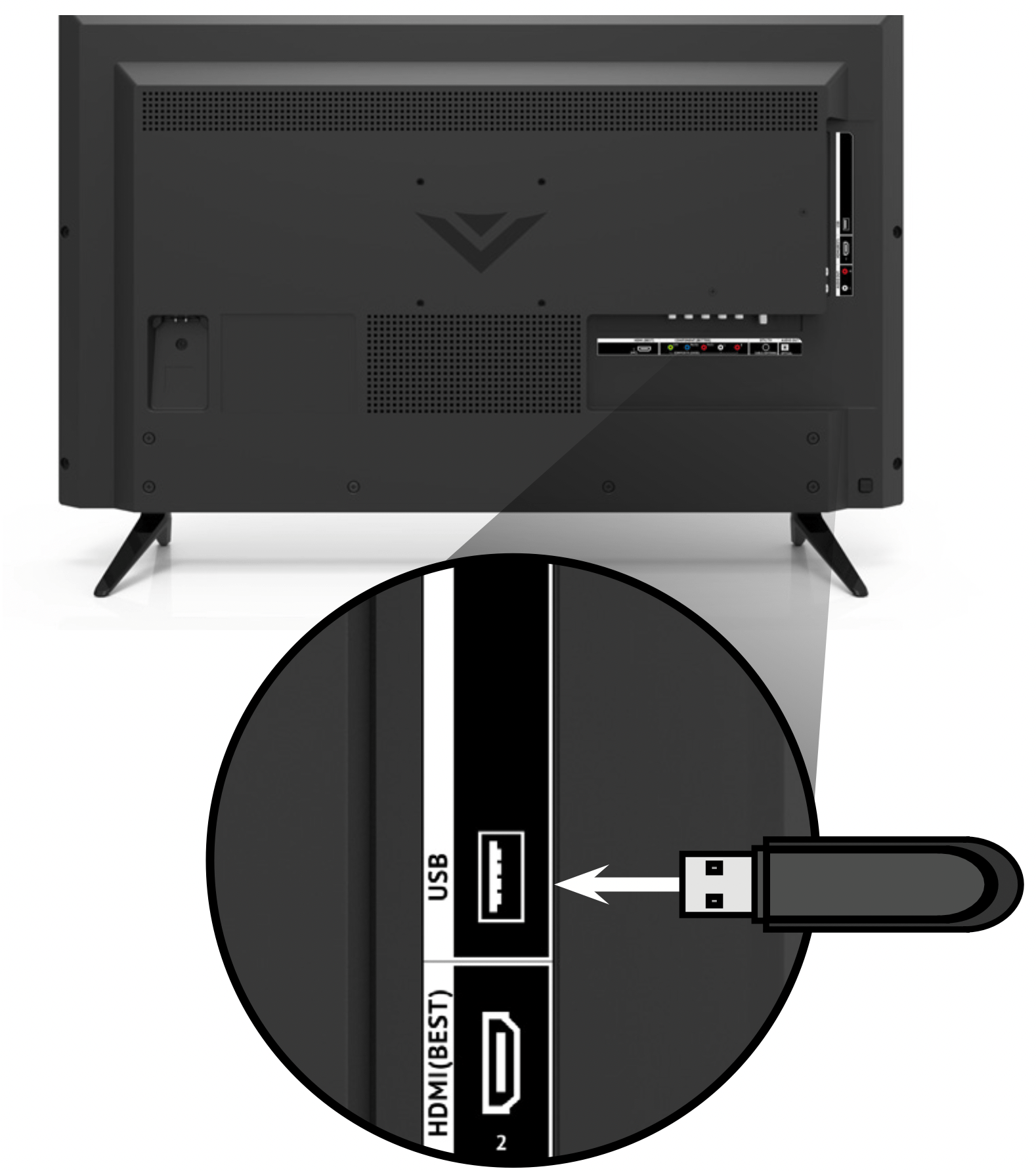
Preparing Your USB Drive to Play USB Media
To display USB media, you must first save your photos onto a USB thumb drive:
- The USB thumb drive must be formatted as FAT32.
- Files on the USB thumb drive must end in a supported file extension ( .jpg or .jpeg).
- The player is not designed to play media from external hard drives, MP3 players, cameras, or smartphones
Displaying USB Media
To display your USB media:
- Connect your USB thumb drive to the USB port on the side of the TV.
- Use the Arrow buttons to highlight the Yes and press OK. (The highlighted App is in the center of the dock.)
- Use the Arrow buttons to highlight the USB drive from the list and press OK.
- Use the Arrow buttons to highlight Photo and press OK.
- Use the Arrow buttons to highlight the file you want to display.
Press OK. The photos display.
You can display your photos in fullscreen. Select the photo, press OK, then highlight Fullscreen and press OK.
Removing the USB Drive from the TV
To safely remove your USB drive from the TV:
- Turn off the TV.
- Disconnect your USB thumb drive from the USB port on the side of the TV.
CAUTION: Do not remove the USB thumb drive while the TV is on. Doing so may damage the drive.

TROUBLESHOOTING
The remote is not responding.
- Make sure the batteries are properly inserted matching the - and + symbols.
- Replace the batteries with fresh ones.
The TV displays “No Signal.”
- Press the INPUT button on the remote control to select a different input source.
- If you are using cable TV or antenna connected directly to the TV, scan for channels. See Scanning for Channels on page 31.
There is no power.
- Ensure the TV is plugged into a working electrical outlet.
- Ensure the power cable is securely attached to the TV.
- Press the Power/Standby button on the remote or on the back of the TV to turn the TV on.
The power is on, but there is no image on the screen.
- Ensure all cables are securely attached to the TV.
- Ensure all devices are connected correctly. Devices differ; see your device’s user manual for details.
- Adjust Brightness, Contrast, or Backlight. See Adjusting the Picture Settings on page 22.
- Press the INPUT button on the remote to select a different input source.
There is no sound.
- Press Volume Up on the remote control.
- Press the MUTE button on the remote to ensure mute is off.
- Check the audio settings. See Adjusting the Audio Settings on page 28.
- Check the audio connections of external devices (Blu-ray player, game console, cable/satellite box) that are connected to the TV.
- If you are using an antenna, the signal strength of the channel may be low. Ensure your antenna is connected securely to the TV and move the antenna around the room or close to a window for the best signal.
The sound is flat or dialog is not audible.
- Turn off Volume Leveling. See Adjusting the Audio Settings on page 28.
The colors on the TV don’t look right.
- Adjust the Color and Tint settings in the Picture menu. See Adjusting the Picture Settings on page 22.
- Select a pre-set picture mode. See Adjusting the Picture Settings on page 22. VIZIO recommends selecting Calibrated.
- Check all cables to ensure they are securely attached.
The buttons on the remote aren’t working.
- Ensure you are only pressing one button at a time.
- Point the remote directly at the TV when pressing a button.
- Replace the remote batteries with new ones. See Replacing the Batteries on page 9.
The image quality is not good.
- For the best image quality, view high-definition programs using digital sources. Connect your devices with HDMI cables.
- If you are using an antenna, the signal strength of the channel may be low. Ensure your antenna is connected securely to the TV and move the antenna around the room or close to a window for the best signal.
The picture is distorted.
- Move the TV away from electrical appliances, cars, and fluorescent lights.
- Ensure all cables are securely attached.
The display image does not cover the entire screen.
- If you are using TV, AV, or Component with 480i input, press the
 button on the remote to change the screen mode.
button on the remote to change the screen mode.
The TV has pixels (dots) that are always dark.
- Your HD TV is precision-manufactured using an extremely high level of technology. However, sometimes pixels may not display correctly. These types of occurrences are inherent to this type of product and do not constitute a defective product.
I see “noise” or static on the screen.
- When your TV’s digital capabilities exceed a digital broadcast signal, the signal is up-converted (improved) to match your TV’s display capabilities. This up-converting can sometimes cause irregularities in the image.
- If you are using an antenna, the signal strength of the channel may be low. Ensure your antenna is connected securely to the TV and move the antenna around the room or close to a window for the best signal.
When I change input source, the display image changes size.
- The TV remembers the viewing mode on each input source. If the viewing mode on the new input source differs from the one on the input source you switch from, the difference may be noticeable.
- See Changing the Screen Aspect Ratio on page 21.
